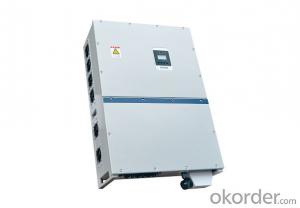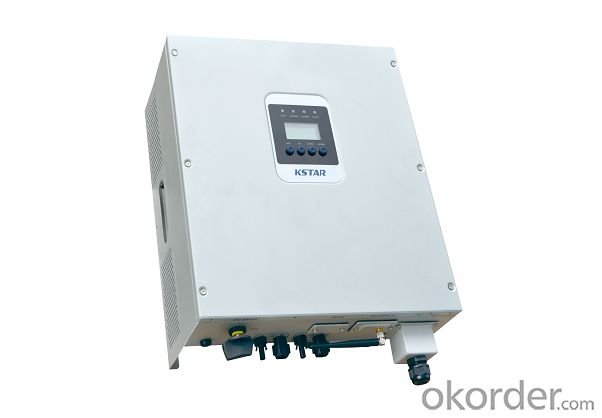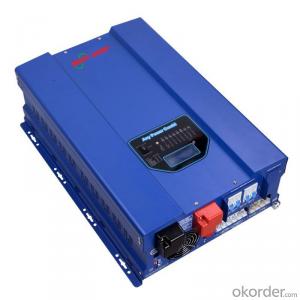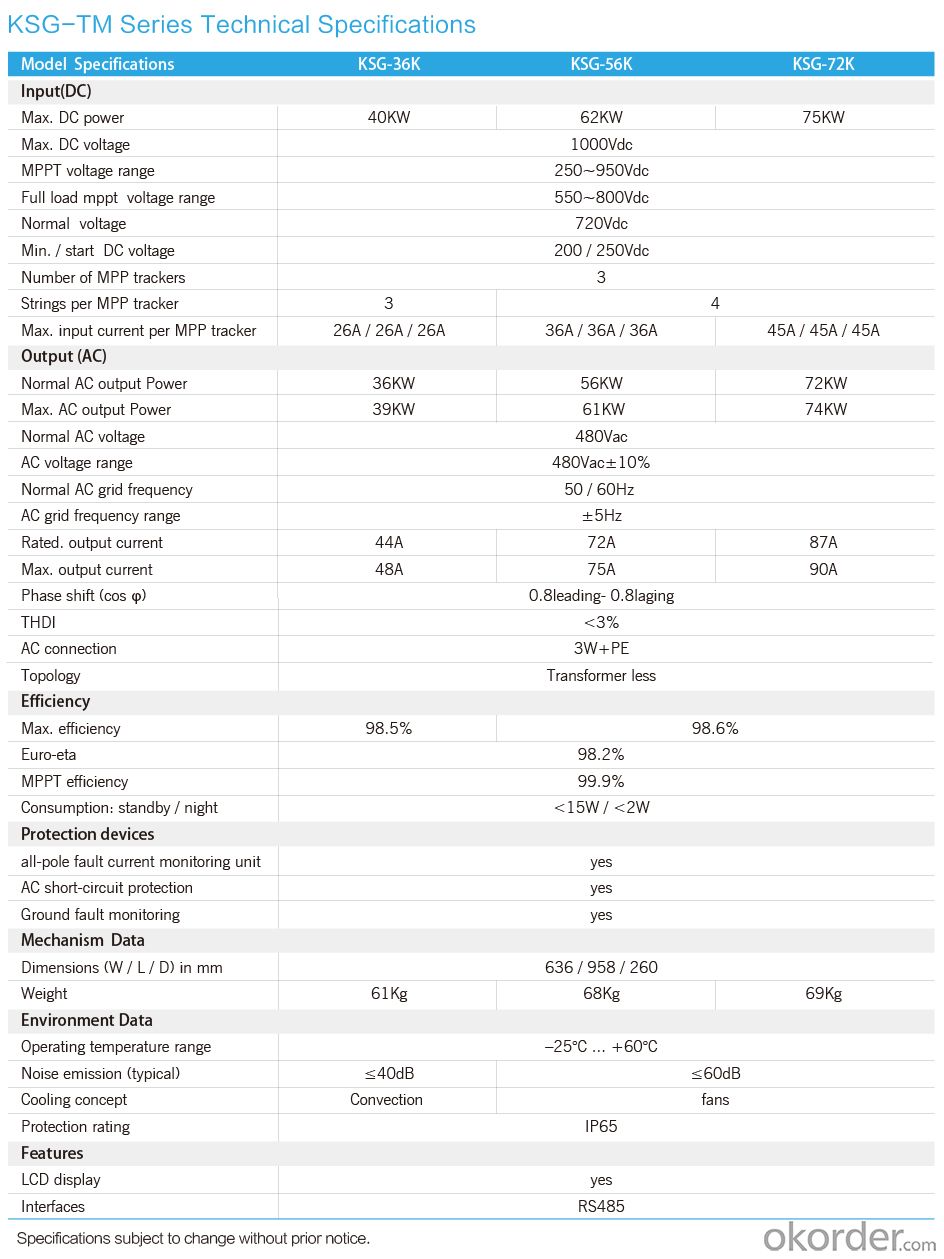5kVA Solar Inverter String Grid-Tied PV Inverter 36kW/56kW/72kW
- Loading Port:
- Guangzhou
- Payment Terms:
- TT OR LC
- Min Order Qty:
- 10 unit
- Supply Capability:
- 10000 unit/month
OKorder Service Pledge
OKorder Financial Service
You Might Also Like
Product features
· Max PV Voltage up to 1000V
· Three MPPT
· High efficiency up to 98.6%
· IP65 protection
· Easy installation
· Reactive power controller
· Digital controller

Product Parameter
Q 1. what's the payment term?
A. We accept TT,30% deposit and 70% balance agaisnt copy of BL
Q 2. how's the delivery time ?
A. usually it will take about 25 days for production
Q 3. tell me the standard of package?
A. For the small capacity, it use carton, but for big capacity, we will use strong wooden case for protection.
Q 4. what kind of material of transformer?
A. we have two types, one 100% copper and the other is copper with aluminum.It depends on your requirment. In fact,those two have no difference if normal work well. Only except the longlife. Copper is better and also higer price.
Q 5.Could you offer Form A or C/O ?
A. It totally not a problem. We can prepare relative documents to forgin affairs office or other office to apply for this certificate.



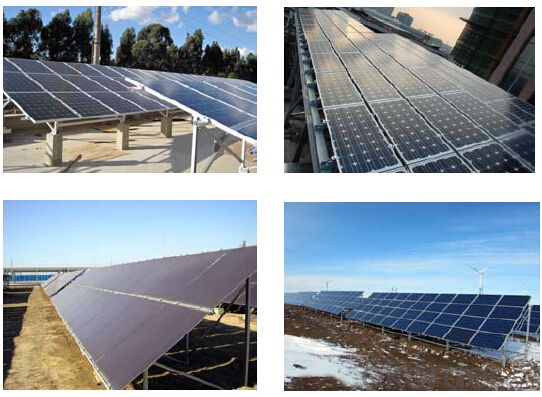


- Q: Are there any limitations on the number of solar panels that can be connected to a single inverter?
- Yes, there are limitations on the number of solar panels that can be connected to a single inverter. The maximum number of panels that can be connected depends on the inverter's capacity and the total wattage of the panels. It is important to ensure that the combined wattage of the panels does not exceed the inverter's maximum input capacity to avoid any potential performance issues or damage to the system.
- Q: How does a solar inverter ensure safety during maintenance?
- A solar inverter ensures safety during maintenance by automatically disconnecting the system from the grid and de-energizing the circuits. This prevents any potential electrical shocks or accidents while the maintenance personnel work on the system.
- Q: How does a solar inverter handle voltage and frequency variations caused by sudden load changes?
- Efficient and reliable, a solar inverter is specifically engineered to manage fluctuations in voltage and frequency resulting from sudden changes in load. When such changes occur, the solar inverter effectively employs a variety of control mechanisms to regulate and stabilize the output voltage and frequency. To begin with, the inverter continuously monitors the incoming solar power, keeping a close eye on the voltage and frequency. If any variations arise due to sudden load changes, the inverter promptly adjusts its internal control systems to compensate. Utilizing advanced power electronics and control algorithms, the inverter ensures that the voltage and frequency remain within the desired range. In order to handle voltage fluctuations caused by sudden load changes, the solar inverter utilizes a technique known as voltage regulation. It automatically adjusts the output voltage, either raising or lowering it as necessary. This guarantees that the inverter delivers a steady and consistent voltage supply to the load, effectively preventing any harm or malfunction. Similarly, to address frequency variations brought on by sudden load changes, the solar inverter employs a technique called frequency regulation. It adjusts the output frequency to match the grid frequency or meet specific frequency requirements. By maintaining the desired frequency, the inverter ensures compatibility and synchronization with the grid or other connected devices. In addition to voltage and frequency regulation, solar inverters also incorporate protective features to handle sudden load changes. They are equipped with built-in overload protection mechanisms capable of detecting excessive loads and preventing damage to both the inverter and the connected devices. These protective features may include safeguards such as overcurrent protection, short-circuit protection, and temperature monitoring. In summary, a solar inverter is purposefully designed to effectively manage voltage and frequency variations arising from sudden load changes. Through its voltage and frequency regulation capabilities, as well as its protective features, the inverter ensures stable and reliable operation. This enables the inverter to adapt efficiently to changing load conditions while safeguarding the integrity of the power supply.
- Q: How does a solar inverter contribute to reducing carbon emissions?
- A solar inverter plays a crucial role in reducing carbon emissions by converting the direct current (DC) electricity generated by solar panels into alternating current (AC) electricity that can be used to power homes and businesses. By enabling the integration of solar power into the electrical grid, solar inverters help to replace conventional fossil fuel-based electricity generation, which is a major source of carbon emissions. This shift towards clean and renewable solar energy helps to reduce carbon emissions and mitigate the adverse effects of climate change.
- Q: Can a solar inverter be used with a solar-powered disaster relief system?
- Yes, a solar inverter can be used with a solar-powered disaster relief system. A solar inverter is an essential component of a solar power system, converting the direct current (DC) generated by solar panels into alternating current (AC) that can be used to power electrical devices. In a disaster relief system, solar panels capture sunlight and convert it into electricity, which is then fed into the inverter to produce usable AC power for various relief operations such as lighting, charging devices, or running essential equipment. Thus, a solar inverter is crucial in enabling the functionality and effectiveness of a solar-powered disaster relief system.
- Q: What is the role of a power control feature in a solar inverter?
- The role of a power control feature in a solar inverter is to efficiently manage and optimize the power output generated by the solar panels. It helps regulate the flow of electricity, maintaining a stable voltage and frequency, while also ensuring that the maximum power point tracking (MPPT) is achieved. This feature allows for better performance, increased energy production, and the ability to adapt to changing sunlight conditions, ultimately maximizing the overall efficiency of the solar inverter system.
- Q: Can a solar inverter be used in locations with high humidity or extreme temperatures?
- Yes, solar inverters are designed to withstand high humidity and extreme temperatures. They are built with robust materials and protective coatings to ensure reliable operation in various environmental conditions. Additionally, many solar inverters undergo extensive testing and are certified to meet industry standards for performance and durability in challenging climates.
- Q: In a photovoltaic grid-connected project, the role of the inverter is to convert the voltage into AC 220V or 380V for the grid, since the transformer will raise the voltage again
- Spontaneous use is a way of grid, that is issued to the electricity, mainly their own family or internal use, the excess part of the power to the grid
- Q: How does a solar inverter affect the overall efficiency of a solar system?
- A solar inverter plays a crucial role in converting the direct current (DC) produced by solar panels into alternating current (AC) that can be used to power household appliances and feed into the electrical grid. It directly affects the overall efficiency of a solar system by maximizing the power output, reducing energy losses during conversion, and ensuring optimal functioning of the system. A high-quality solar inverter can significantly improve the efficiency of a solar system, resulting in increased energy generation and cost savings.
- Q: Can a solar inverter be used for both grid-tied and off-grid systems?
- No, a solar inverter cannot be used for both grid-tied and off-grid systems. Grid-tied inverters are designed to convert solar energy into electricity and feed it back into the grid, while off-grid inverters are designed to convert solar energy into usable electricity for standalone systems not connected to the grid. The requirements and functionalities of both types of systems are different, so separate inverters are needed for each.
Send your message to us
5kVA Solar Inverter String Grid-Tied PV Inverter 36kW/56kW/72kW
- Loading Port:
- Guangzhou
- Payment Terms:
- TT OR LC
- Min Order Qty:
- 10 unit
- Supply Capability:
- 10000 unit/month
OKorder Service Pledge
OKorder Financial Service
Similar products
Hot products
Hot Searches
Related keywords
